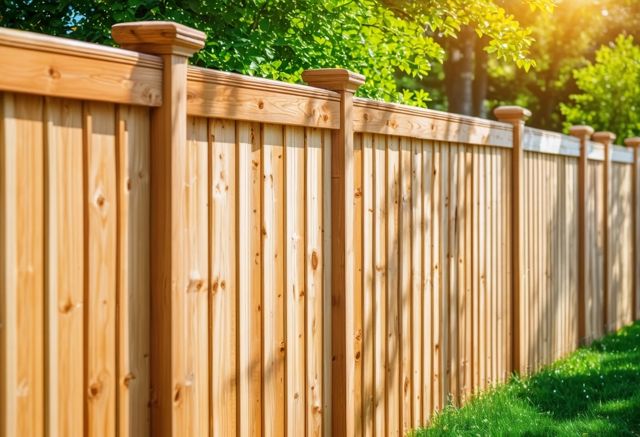Thoroughly plan your installation by verifying local regulations and outlining your fence layout with stakes and twine. Gather all necessary tools and materials beforehand to ensure a smooth and efficient process.
Planning Your Wood Fence Installation
This section focuses on the initial planning phase of wood fence installation, including understanding property lines, checking local regulations, and determining the layout and design of the fence.
Before you start installing wood fence panels, it’s crucial to plan thoroughly. This will save you time, money, and potential issues down the road.
First, verify local building permits, height restrictions, and zoning laws. Check if you need written permission from your neighbors and use services to mark any buried utilities to avoid damage.
Gather all necessary tools and materials. Essential tools include:
- Circular saw, cordless drill, and electric miter saw
- Hammer, tape measure, speed square, and twine
- Stakes, level, post-hole digger, shovel, pencil, and protective gear
Next, create a detailed layout of your fence. Use stakes and twine to outline the fence line. Graph paper can help map out post and gate locations. Ensure corners are squared by measuring diagonals.
Dig post holes to the required depth, typically half the length of the post and three times its width. Add gravel for drainage before placing posts in the holes. Brace the posts and fill the holes with dry quick-set concrete followed by water.
Planning also includes choosing the right design. Decide if you want the posts to face inside or outside for aesthetic preferences.
Proper preparation ensures your wood fence installation is smooth and effective, enhancing your property’s privacy, security, and appearance.

Gathering Materials and Tools
To install wood fence panels efficiently, gather all necessary materials and tools ahead of time. This ensures a smooth installation process without unnecessary interruptions.
You’ll need:
- Wood panels and posts: Choose quality wood suited for your design and environment.
- Nails and Screws: Use galvanized nails and screws to prevent rusting.
- Digging Equipment: Have a post hole digger or auger for setting posts.
Additionally, consider:
- Concrete mix: For setting posts securely.
- Measuring tools: Tape measure and level for accuracy.
- Saw: For cutting panels and posts to size.
- Protective gear: Gloves and safety glasses to protect yourself.
Having these materials and tools ready will make the installation process more efficient and safer.
Step-by-Step Installation Process
Step-by-Step Installation Process
Begin by gathering all necessary tools and materials. This will ensure you have everything on hand and can proceed smoothly.
- Digging Post Holes: – Use a post hole digger to create holes for your posts. – Ensure holes are at least one-third the height of the posts. – Make sure the depth is adequate to prevent the fence from tipping over.
- Setting Posts: – Place posts in the holes and ensure they are plumb (vertically aligned). – Use concrete to secure posts in place. – Allow the concrete to cure fully before proceeding.
- Attaching Panels: – Start at one corner and work your way along the fence line. – Ensure each panel is level before attaching. – Use screws or nails designed for outdoor use to secure panels to posts.
- Ensuring Proper Alignment: – Regularly check alignment as you install each panel. – Use a string line between posts for a straight fence line. – Make necessary adjustments to maintain a consistent height and alignment.
Following these steps will help ensure a sturdy and visually appealing wood fence.

Ensuring Durability and Maintenance
Maintaining your wood fence is key to ensuring its longevity and keeping your property looking its best. Here are some essential tips:
- Regular Inspections: Periodically check your fence for signs of damage such as rot, cracks, or insect infestation. Catching problems early can prevent costly repairs and extend the fence’s life.
- Staining and Sealing: Apply a wood stain and sealant to protect your fence from moisture and UV damage. This not only enhances its appearance but also adds a layer of protection against the elements.
- Cleaning: Keep your fence clean by removing dirt, mold, and mildew. Use a mild detergent and a soft brush to scrub the surface, then rinse with water. Regular cleaning prevents buildup that can cause damage over time.
- Repairing Damage: Address any issues immediately. Replace damaged boards, fix loose nails, and reinforce any weak spots to maintain the fence’s structural integrity.
- Vegetation Control: Trim back any plants or vines growing on or near the fence. Overgrown vegetation can trap moisture against the wood and lead to rot.
These practices will help ensure your wood fence remains strong and attractive for years. For professional fencing solutions and expert craftsmanship, consider Pickets.

FAQ
What is the first step in planning a wood fence installation?
Before starting the installation, it’s crucial to verify local building permits, height restrictions, and zoning laws. You should also check if you need written permission from your neighbors and mark any buried utilities to avoid damage.
What tools are essential for wood fence installation?
Essential tools include a circular saw, cordless drill, electric miter saw, hammer, tape measure, speed square, twine, stakes, level, post-hole digger, shovel, pencil, and protective gear.
How should I outline the fence line?
Use stakes and twine to outline the fence line. Graph paper can help map out post and gate locations. Ensure corners are squared by measuring diagonals.
What is the recommended depth for digging post holes?
Dig post holes to the required depth, typically half the length of the post and three times its width. Add gravel for drainage before placing posts in the holes.
How do I set the posts securely?
Place posts in the holes, brace them, and fill the holes with dry quick-set concrete followed by water. Ensure that the posts are plumb and allow the concrete to cure fully before proceeding.
What materials are needed for installing wood fence panels?
You’ll need wood panels and posts, galvanized nails and screws, a post hole digger or auger, concrete mix, measuring tools like a tape measure and level, a saw, and protective gear.
How do I attach the wood fence panels to the posts?
Start at one corner and work your way along the fence line. Ensure each panel is level before attaching it to the posts using screws or nails designed for outdoor use.
How can I ensure proper alignment during installation?
Regularly check alignment as you install each panel. Use a string line between posts to maintain a straight fence line and make necessary adjustments to ensure consistent height and alignment.
What are some maintenance tips for ensuring the durability of a wood fence?
Regularly inspect your fence for damage, apply wood stain and sealant, keep it clean, repair any damage immediately, and control vegetation to prevent moisture buildup. These practices will help ensure your wood fence remains strong and attractive for years.

